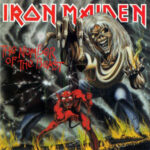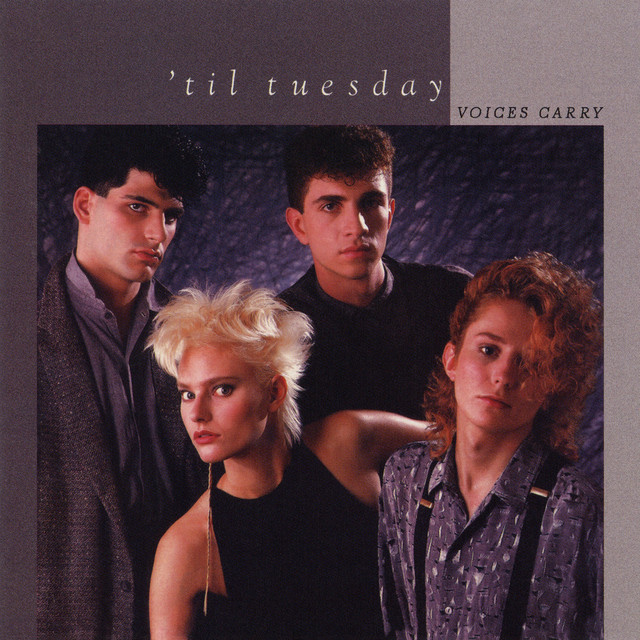 In 1982, Iron Maiden released “The Number of the Beast,” a song that would come to define both the band’s career and the trajectory of heavy metal in the early 1980s. As the title track of their third studio album, it marked a turning point for Iron Maiden, showcasing their combination of intricate guitar work, operatic vocal delivery, and dark, narrative-driven lyrics. The song immediately captured the imagination of metal fans worldwide, blending galloping rhythms, ominous synthesizer-like effects, and dramatic storytelling into a sonic experience that was as thrilling as it was intimidating. Drawing inspiration from horror imagery, biblical references, and classic literature, “The Number of the Beast” explores themes of fear, temptation, and supernatural forces, providing listeners with a vivid, cinematic journey through darkness and chaos. Bruce Dickinson’s commanding vocals, combined with Dave Murray and Adrian Smith’s dual guitar harmonies and Steve Harris’s thunderous bass lines, elevate the song beyond mere shock value, transforming it into a meticulously crafted metal masterpiece. Its enduring popularity lies not only in its aggressive instrumentation and theatrical flair but also in its narrative depth, proving that heavy metal could be both intellectually engaging and viscerally exhilarating. Over four decades later, “The Number of the Beast” remains a benchmark for metal music, influencing countless bands and solidifying Iron Maiden’s legacy as pioneers of the genre.
In 1982, Iron Maiden released “The Number of the Beast,” a song that would come to define both the band’s career and the trajectory of heavy metal in the early 1980s. As the title track of their third studio album, it marked a turning point for Iron Maiden, showcasing their combination of intricate guitar work, operatic vocal delivery, and dark, narrative-driven lyrics. The song immediately captured the imagination of metal fans worldwide, blending galloping rhythms, ominous synthesizer-like effects, and dramatic storytelling into a sonic experience that was as thrilling as it was intimidating. Drawing inspiration from horror imagery, biblical references, and classic literature, “The Number of the Beast” explores themes of fear, temptation, and supernatural forces, providing listeners with a vivid, cinematic journey through darkness and chaos. Bruce Dickinson’s commanding vocals, combined with Dave Murray and Adrian Smith’s dual guitar harmonies and Steve Harris’s thunderous bass lines, elevate the song beyond mere shock value, transforming it into a meticulously crafted metal masterpiece. Its enduring popularity lies not only in its aggressive instrumentation and theatrical flair but also in its narrative depth, proving that heavy metal could be both intellectually engaging and viscerally exhilarating. Over four decades later, “The Number of the Beast” remains a benchmark for metal music, influencing countless bands and solidifying Iron Maiden’s legacy as pioneers of the genre.
Iron Maiden: Forging the New Wave of British Heavy Metal
By the time “The Number of the Beast” was released, Iron Maiden had already established themselves as central figures in the New Wave of British Heavy Metal (NWOBHM). Formed in 1975 by bassist and primary songwriter Steve Harris, the band’s early work showcased raw energy, technical proficiency, and a keen sense of melody. With the addition of Bruce Dickinson as lead vocalist in 1981, Iron Maiden gained a more dynamic and theatrical vocal presence, perfectly complementing Harris’s galloping bass lines and the dual guitar attack of Dave Murray and Adrian Smith.
The band’s approach to songwriting combined speed, precision, and narrative complexity. Tracks like “The Number of the Beast” exemplify this approach, merging rapid tempos with melodic hooks and storytelling, creating songs that are both sonically intense and intellectually stimulating. Iron Maiden’s ability to balance technical mastery with accessibility allowed them to appeal to both metal purists and broader rock audiences, ensuring their music resonated across the globe.
Origins and Inspiration of “The Number of the Beast”
The song “The Number of the Beast” was inspired by Steve Harris’s fascination with horror films, religious imagery, and the literary tradition of dark storytelling. Harris has described the track as a narrative exploration of fear and temptation, drawing on the symbolic resonance of the number 666, often associated with the devil and apocalyptic visions.
The lyrics open with a sense of foreboding and panic:
“Woe to you, oh Earth and Sea, for the Devil sends the beast with wrath
Because he knows the time is short…”
This immediately sets the stage for a story of cosmic horror, blending biblical references with vivid, cinematic imagery. The narrative approach, combined with intricate musical arrangements, elevates the song from a simple heavy metal anthem to a dark musical epic, inviting listeners into a world of dread, suspense, and supernatural intrigue.
Musical Composition and Arrangement
Musically, “The Number of the Beast” is a masterclass in early 1980s metal craftsmanship. The song begins with a dramatic spoken-word introduction by actor Barry Clayton, recounting a nightmare vision of demonic forces, setting an ominous tone that perfectly complements the thematic content. This intro immediately immerses the listener in the song’s narrative, creating a sense of tension and anticipation that will be resolved through the instrumentation.
Steve Harris’s signature galloping bass line drives the rhythm, providing both momentum and a sense of urgency. This iconic rhythm, combined with Nicko McBrain’s precise and energetic drumming, creates a foundation that is both relentless and engaging. Over this base, Dave Murray and Adrian Smith weave harmonized guitar riffs and solos that alternate between menacing dissonance and soaring melodic passages, reinforcing the song’s dramatic arc.
The chorus, with its memorable chant of “666, the number of the beast,” provides both catharsis and thematic clarity, anchoring the song’s narrative while amplifying its emotional intensity. The interplay between rhythmic drive, melodic guitar lines, and theatrical vocals exemplifies Iron Maiden’s approach to metal composition, where each element serves the story as well as the music.
Bruce Dickinson’s Vocals
Bruce Dickinson’s vocal performance is central to the song’s power and theatricality. His wide vocal range, dynamic phrasing, and dramatic delivery bring the lyrics to life, transforming the narrative from abstract horror imagery into an immediate, emotionally compelling experience.
In the verses, Dickinson alternates between ominous menace and urgent storytelling, while in the chorus he soars with a sense of grandeur and defiance. His ability to convey both fear and triumph enhances the song’s narrative tension, making the listener feel the psychological weight of the “nightmare” scenario described in the lyrics. Dickinson’s performance demonstrates the role of vocals in metal as both a narrative tool and a musical instrument, capable of carrying melody, emotion, and thematic resonance simultaneously.
Lyrics and Thematic Content
The lyrics of “The Number of the Beast” explore themes of fear, supernatural power, and moral struggle. The song’s narrative perspective—centered on a nightmarish vision of demonic forces—creates an immersive storytelling experience. Lines such as:
“This can’t go on, I must inform the law
Can this still be real or just some crazy dream?”
highlight the tension between reality and nightmare, a common motif in horror literature and film. The repeated invocation of 666, alongside biblical and apocalyptic imagery, reinforces the sense of cosmic dread and inevitability, lending the song a mythic and timeless quality.
The lyrics also reflect broader social and cultural anxieties of the early 1980s, a period marked by political unrest, Cold War tensions, and fascination with occult imagery in popular culture. By channeling these fears into a compelling musical narrative, Iron Maiden created a song that resonates on both a personal and collective level.
Production and Sound Aesthetic
Produced by Martin Birch, “The Number of the Beast” showcases the clarity, intensity, and precision of early 1980s metal production. Birch’s work emphasized the interplay between rhythm, melody, and vocal performance, ensuring that each element of the song was both distinct and integrated.
The production highlights Harris’s galloping bass, the dual guitars of Murray and Smith, and Dickinson’s dramatic vocals, while McBrain’s drums provide both power and momentum. The layering of guitars, combined with strategic use of reverb and echo, enhances the song’s cinematic quality, creating a soundscape that feels both expansive and claustrophobic—perfectly matching the lyrics’ apocalyptic themes.
Reception and Cultural Impact
Upon its release, “The Number of the Beast” was both celebrated and controversial. Its dark imagery and association with Satanic themes sparked moral panic among certain conservative groups, leading to debates about heavy metal’s influence on youth culture. However, these controversies only fueled the song’s popularity, drawing attention to Iron Maiden’s theatrical approach and the song’s musical complexity.
The track quickly became a fan favorite and a defining anthem for Iron Maiden, helping to solidify their reputation as leaders of the NWOBHM movement. Its success also paved the way for subsequent albums, demonstrating that metal could combine narrative sophistication, technical mastery, and commercial appeal.
Live Performances and Legacy
Live performances of “The Number of the Beast” amplify the song’s intensity and theatricality. Iron Maiden often incorporates elaborate stage effects, lighting, and props to recreate the song’s apocalyptic narrative, enhancing the audience’s immersion. Dickinson’s commanding stage presence and vocal prowess bring additional energy, transforming the track into a live spectacle that is both emotionally and sonically overwhelming.
Over the decades, the song has influenced countless metal and rock bands, inspiring musicians to explore thematic storytelling, complex arrangements, and theatrical performance. Its enduring popularity is evident in its frequent inclusion in greatest hits compilations, live setlists, and covers by other artists.
Why “The Number of the Beast” Matters Today
The Number of the Beast endures because it exemplifies the synthesis of musical craftsmanship, narrative depth, and cultural resonance. Its combination of galloping rhythm, dual guitar harmonies, dramatic vocals, and apocalyptic storytelling sets a standard for metal that remains influential decades after its release.
The song’s exploration of fear, morality, and supernatural power continues to resonate with listeners, offering both emotional catharsis and intellectual engagement. It demonstrates that heavy metal is not merely a genre of sonic aggression but also a medium for storytelling, thematic exploration, and cultural commentary.
Final Reflections
Iron Maiden’s “The Number of the Beast” is more than a seminal metal track from 1982; it is a masterful fusion of musical innovation, theatricality, and narrative depth. Its intricate guitar work, thunderous rhythm section, and commanding vocals create a sonic landscape that is both immersive and exhilarating, while its lyrics explore themes of fear, power, and cosmic horror.
By combining technical proficiency with storytelling, Iron Maiden crafted a song that transcends its era, remaining a cornerstone of heavy metal and a benchmark for narrative-driven music. The Number of the Beast continues to captivate audiences, influence musicians, and inspire devotion, proving that heavy metal can be both intellectually compelling and emotionally electrifying. Decades after its release, the track remains a symbol of rebellion, imagination, and the enduring power of music to evoke awe and terror in equal measure.


